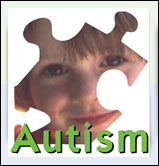Collaborative Programs of Excellence in Autism (CPEAs): Network on the Neurobiology and Genetics of Autism—Where are we now?
 "Solving the puzzle of autism will be like peeling an onion," said Dr. Marie Bristol-Power, former Special Assistant for Autism in the Office of the Director at the NICHD. "It will happen one layer at a time."
"Solving the puzzle of autism will be like peeling an onion," said Dr. Marie Bristol-Power, former Special Assistant for Autism in the Office of the Director at the NICHD. "It will happen one layer at a time."
Dr. Bristol-Power's statement, uttered in 2001, turned out to be prophetic. After nearly 10 years of peeling, we still haven't solved the puzzle of autism. But CPEA researchers have made significant progress in understanding this complex disorder. For example, because of the CPEAs, researchers now have data on the genetics and characteristics of the largest group of well-diagnosed persons with autism in the world.
Looking back, we also find that the CPEA Network’s contributions go beyond research findings.
The Network and its projects have provided a new model of scientific collaboration that really works—one that other Institutes and agencies are now using. For example, the Studies to Advance Autism Research and Treatment (STAART), a $65 million effort initiated in response to the Children's Health Act of 2000 supported by the NICHD and four other NIH Institutes, mirrors the successful structure of the CPEA Network. The STAART centers all contribute to collaborative projects to learn more about autism causes, diagnosis, early detection, and treatment, while also conducting and supporting individual center studies on these topics.
In addition, the Network was a hotbed for new ideas, which have led to new projects now in progress both in the United States and internationally. For instance, the Baby Siblings Research Consortium, which grew out of a 2003 meeting about siblings of those born with ASDs (a group at high risk for autism), is a new project independent of the CPEA Network. The Consortium seeks to understand the earliest behavioral and biomedical markers of autism, while also learning about the range of symptoms that people with autism experience. The project builds on the successful structure of the CPEA Network in that investigators contribute to collaborative projects—pooling their patients and their data and addressing common research questions. At the same time, investigators take part in smaller, subgroup research projects to contribute to the overall mission of the Consortium.
The culture of collaboration created by the CPEA researchers and families has also extended into the autism support community, so that research agencies and organizations work together with autism support groups to fund and conduct important research.
These unique interactions actually predate the start of the CPEA Network. In 1995, the NICHD and other NIH Institutes hosted a congressionally mandated State-of-the-Science Conference on Autism, in cooperation with the Autism Society of America and the Autism National Committee. At this meeting, researchers and support organizations worked together to establish a research agenda that would help guide autism research.
In another significant example of collaboration, CPEA researchers are key contributors to the International Meeting for Autism Research (IMFAR), an effort to promote communication and interdisciplinary collaboration. IMFAR is underwritten by Cure Autism Now, the National Alliance for Autism Research, and the University of California, Davis, M.I.N.D. Institute, one of the CPEA sites. The 2006 IMFAR included more than 900 scientists from around the world who presented research on early diagnosis, interventions, brain structure and neurophysiology, and genetics, to name a few topics. Organizers for IMFAR also noted that researchers submitted more than 500 abstracts on research into the nature, causes, and treatments of ASDs.
Other similar types of collaborations include:
- CPEA investigators have been members of the International Molecular Genetic Study of Autism Consortium (IMGSAC) since the Network began. IMGSAC researchers use state-of-the-art technology for genetic studies of more than 1,500 families with autism in hopes of identifying the genes involved.
- Researchers from the CPEA Network are active members of the International Society for Autism Research (ISAR), a group that fosters collaboration among scientists and health care providers to conduct the highest quality interdisciplinary research on ASDs. The ISAR organizes the IMFAR meeting with the event underwriters.
- The Baby Siblings Research Consortium, explained above, is a collaboration between the NICHD and the autism support organization Autism Speaks
 (formerly two separate organizations, Autism Speaks and the National Alliance for Autism Research).
(formerly two separate organizations, Autism Speaks and the National Alliance for Autism Research). - CPEA researchers and colleagues at other NIH Institutes also contribute to the Autism Genetic Resource Exchange
 , a project sponsored by Cure Autism Now.
, a project sponsored by Cure Autism Now. - A partnership between the National Alliance for Autism Research, the NICHD, and three other NIH Institutes supports the Autism Genome Project
 (PDF - 106 KB). The Project brings together four large research teams—IMGSAC, AGRE, STAART, and CPEA—joining more than 150 researchers worldwide in a search for autism susceptibility genes.
(PDF - 106 KB). The Project brings together four large research teams—IMGSAC, AGRE, STAART, and CPEA—joining more than 150 researchers worldwide in a search for autism susceptibility genes. - Liaisons from parent support groups, professional organizations, the CPEAs, and other Institutes worked together on Screening and Diagnosis of Autistic Spectrum Disorders (1999, Journal of Autism and Developmental Disabilities, 26[6]: 439-484). The article provided guidance for health care providers, offered "red flags" for autism that parents and families could recognize, and later formed the basis for practices now used by the American Academy of Neurology, the American Academy of Pediatrics, and the Child Neurology Society.
- The CPEA Network Advisors include representatives from support organizations and research foundations, including National Alliance for Autism Research and Cure Autism Now.
 BACK TO TOP
BACK TO TOP